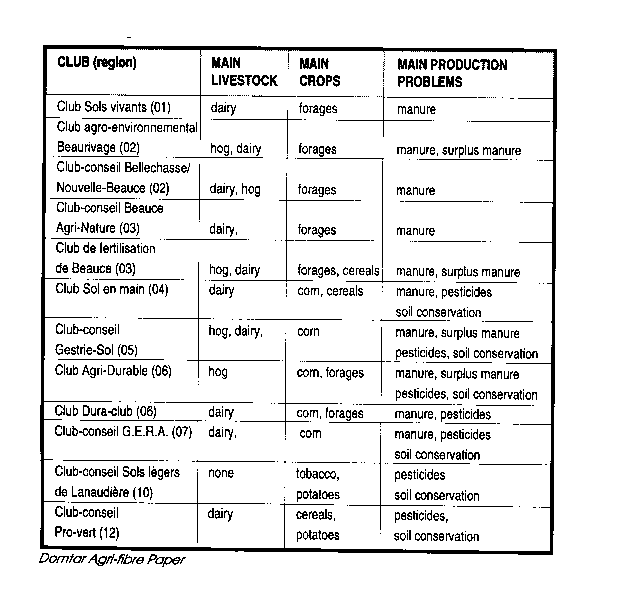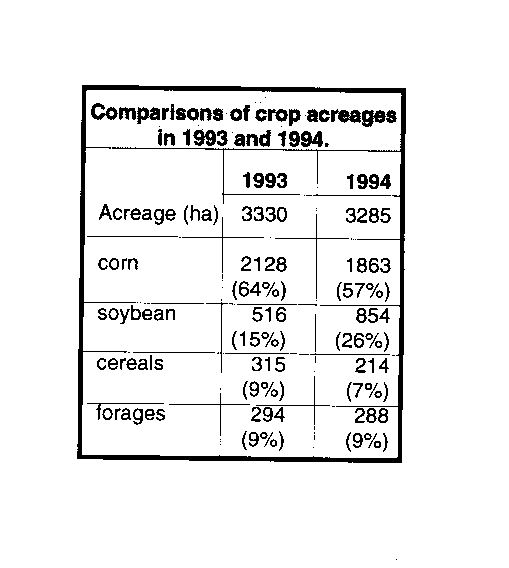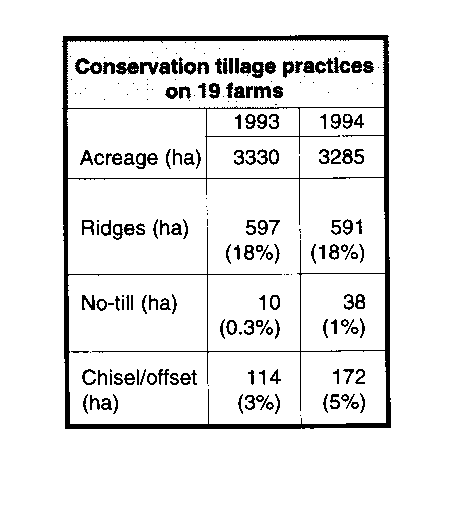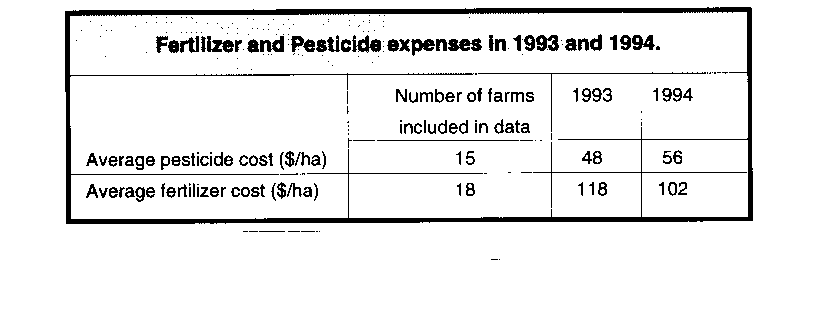
Sustainable Farming Index | Virtual Library | Magazine Rack
Search
| Ecological Solutions Roundtable
(One map, two photos)
Province-wide program:
The farmer club approach in Quebec helps transition to sustainable agriculture
by Chantal Foulds, agronomist
For several years, Quebec farmers have been forming financial management clubs and have been subsidized (50 % and upwards) by the government to hire agronomists. The longest type of these clubs in existence have been the Syndicats de Gestion.
But more recently, production clubs, with more emphasis placed on production techniques have been forming. There are now clubs found across the province focused on everything from beef production to organic farming.
In 1993, the provincial government decided to take this farmer club concept and test it. Twelve Clubs-conseils were selected for evaluation. The clubs had to have among their main objectives:
• a conservation of water and soil resources;
• integrated pest management;
• and a reduction of non-point source pollution.
Each of these farmer production clubs is being subsidized by as much as 90% of budgeted costs from August 1993 to March 1997. In return, each farm in a club has to provide financial and agronomic data, as well as establish an individual farm conservation plan.
The Quebec government hopes to see if its investment in the farmer club program pays off. In the end, the government is hoping the club approach will encourage more farmers to adopt sustainable-type agricultural practices.
The Club-conseils that have been formed across Quebec, the areas where they are located , and the characteristics of each club are summarized below.

One group, one approach
In the fall of 1993, each club had to present a set of specific objectives for the duration of the program, that is until March 1997.
For example, the objectives established for the Club-conseil G.E.R.A located in the Chateauguay Valley and Vaudreuil Soulanges region are:
• fertilizer use will be reduced; 40% less nitrogen, 40% less phosphorus and 60% less potassium;
• 35% of the corn acreages currently receiving pesticides will be reduced;
• conservation tillage already being done on 650 ha (21%) of the acreages will be increased;
• the total cost of production per ha for corn will be reduced by a minimum of 10%;
• energy crop production requirements will be reduced by 20%;
• and information exchanges will be promoted.
Each club requires different approaches because of the environmental differences in each region, and the individual farms involved in each group.
For example, the Club-conseil G.E.R.A. (region 7) members are predominantly cash crop farms planted mostly to corn; of the 3000 ha managed in the club approximately 2000 ha are in corn. The land is relatively flat and composed of heavy soils; silt loams to clays for the most part. There are eight dairy farms, two poultry and one beef operation in the Club-conseil G.E.R.A, and the farms do not have enough manure to cover all their land. In this region, animal based production systems are on the decline. So, several of the farms in the club have already adopted conservation tillage practices. Five farmers are using ridge tillage and one other farmer is seriously experimenting with no-till.
As far as the agronomist for the Club-conseil G.E.R.A is concerned: at the root of all farming systems there must be a good rotation. So, from the onset of the program, the agronomist, with input from each farmer in the club, established a projected rotation towards which each farm will eventually evolve.
The main objective for the club's farms is to reduce the number of years of continuous corn. Secondly, a nutrient budget has been established using average soil tests for the farms, nitrogen credits for various crops and manure nutrients. The result (nutrients to be supplied by fertilizer) was compared to 1993 applications of fertilizer to give an idea of how much fertilizer would be saved by each farmer. The average fertilizer reductions for all 20 farms in the club became the group's main objective.
Concentrated on reductions
The first field season (1994) was concentrated on reducing fertilizer applications in the crops. Before reducing pesticide use, the agronomist wanted to be assured that all the farms were not over- fertilizing. Over-fertilization would hinder any further attempt to reduce pesticide use. Almost every club member had fertilisation trials, mostly in corn and soybeans, comparing different rates. The agronomist's job was to collect the appropriate data to detect any differences between treatments. In the fall, the farmers had an information exchange day where they explained and compared their trials and their results.
After one field season, the data collected from the club's farms showed the following reductions in fertilizer use:
• 16% less nitrogen;
• 23% less phosphorus;
• and 36% less potassium.
These reductions are attributed to several influencing factors:
• an integrated fertilisation plan;
• giving appropriate nitrogen credits;
• calibration of manure applications (manure spreaders were weighed and manure analysis were done);
• and a reduction of corn acreages into an increase in soybean acreages.

This year (1995), more of the club's efforts have been placed on reducing pesticide use. Calibration of sprayer equipment was done for several of the farms, and mechanical weed control trials were increased compared to the amount done in 1994. Three farms will be replacing herbicides in soybeans with rotary hoeing on part or all of their soybean acreage this year.
In terms of conservation tillage practices, slight increases in no till and reduced till were noted from 1993 to 1994 as the following table illustrates:
Conservation tillage practices of 19 farms in 1993 and 1994.

The Club-conseil G.E.R.A collected a few financial figures as well. See box below.

The first year was mainly geared to reducing fertilizer use and the results show, as well, a reduction in fertilizer costs. It will be interesting to see if the cost reduction continues in 1995 as fertilizer costs increased significantly this year.
Little effort was made in 1994 to reduce pesticide use, and as a result no decrease is observed in this cost.
The provincial Club-conseil program continues until March 1997. Until then, the exact degree of influence that the farmer club approach is having on encouraging members to adopt sustainable agricultural practices won't be known. However, early indications are proving favorable.
For additional information on the program, in general, or any of the clubs, in particular, contact: Pierre Beaudet, provincial coordinator, at 418-644-5602 in Quebec City.
Map:
Quebec Agricultural Regions
Photo Cutlines:
Manure application rates were calibrated using electronic road scales supplied by the Quebec department of agriculture.
Gerald Huot, a member of Club-conseil G.E.R.A, interseeded ryegrass in his ridged corn to increase resistance to field traffic and improve soil quality.
Copyright © 1995 REAP Canada
Reprinted with permission. All rights reserved.
Info Request | Services | Become EAP Member | Site Map
Give us your comments about the EAP site
Ecological Agriculture Projects, McGill University (Macdonald
Campus),
Ste-Anne-de-Bellevue, QC, H9X 3V9 Canada
Telephone:
(514)-398-7771
Fax:
(514)-398-7621
Email: info@eap.mcgill.ca
To report problems or otherwise comment on the structure of this site, send mail to the Webmaster